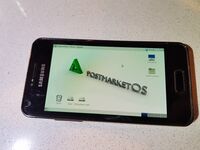MATE
 MATE running on Samsung Galaxy S Advance (i9070) | |
| In postmarketOS | |
|---|---|
| Package | postmarketos-ui-mate |
| Status | Available |
MATE is a desktop environment forked from the maintained code base of GNOME 2. It is installable on postmarketOS.
Status
It works on most devices with a working display, works fine without hardware acceleration. Also it has Hi-Dpi support. So apps will look better and usable. Use packages from Alpine repo.
After the postmarketOS loading splashscreen you will get a black screen for 20-30 seconds before the desktop appears.
This seems due to an issue with marco (MATE window manager):
mate-session[1377]: WARNING: Application 'marco.desktop' failed to register before timeout
Install MATE Desktop
Run pmbootstrap init and choose mate in the interface section.
The Alpine repository already contains all the packages for x86_64, armhf and aarch64 architectures.
Nothing has to be done to enable it.
On Extra packages:
- Add an on-screen keyboard like
onboard,matchbox-keyboardorcorekeyboard, see Input_methods#Conventional_on-screen_keyboards. - The
network-manager-appletis recommendable. It can be added to the panel later.
After installation, the shell will automatically launch upon boot. If it doesn't, have a look at /etc/profile.d/start_mate.sh script.
Add the on-screen keyboard to Preferences -> Personal -> Startup Applicactions. Command e.g. /usr/bin/onboard. Thereafter, logout or reboot.
For the official MATE instructions, see their website.
Display
Follow the Display guide to optionally change it to landscape mode or fix display related issues.
Miscellaneous
- For terminal usage: Change text color within the terminal by Edit -> Profile Preferences -> tab "Colors" -> uncheck "Use colors from system theme" -> choose e.g. built-in scheme "Custom", text color a light grey and backgrund color black (which optionally can be set transparent in the "Background" tab).
- Disable mouse cursor by
sudo vi /etc/lightdm/lightdm.conf, change#xserver-command=Xtoxserver-command=X -nocursor, logout or reboot. - Secondary mouse click see Input_methods#Simulate_secondary_click.
- Add "Battery Charge Monitor" to the panel.
- If you want to use LightDM as a login screen, see Display_manager#LightDM.
- Screen locking is a bit of a challenge.
- The easy part is enabeling it:
- A timed locking in System -> Preferences -> Look and Feek -> Screensaver -> check "Lock screen when screensaver is active".
- By e.g. pressing the power button in System -> Preferences -> Hardware -> Keyboard Shortcuts -> double-click the shortcut next to "Lock screen" -> press the power button to assign.
- The tricky part is getting a virtual keyboard for unlocking, see Screen_locker#mate-screensaver.
- For disabling the inputs, you can try something like Screen_locker:Disable_inputs#Xfce4 but the script sure needs to be adapted to the situation, whicht might not be easy.
- The easy part is enabeling it:
Additional software
- As a browser, install e.g.
firefoxorfirefox-esr. To enable touch screen behaviour, add a new filesudo vi /etc/profile.d/firefox-touch-scrolling.shand writeexport MOZ_USE_XINPUT2=1, inabout:configchangedom.w3c.touch_events.enabledfrom 2 (default, auto-detect) to 1 (enabled). For better touch screen usability, install packagemobile-config-firefox(more information) - For phone applications, try
calls,chattyandgnome-contacts, which are used in Phosh. Packagemodemmanagerneeds to be installed, start the service bysudo rc-service modemmanager start, add it permanently bysudo rc-update add modemmanager defaultand reboot. - To view PDF files, install package
atril, for alternatives see PDF#PDF_viewers.